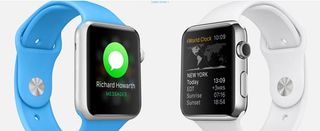Make smart design decisions for wearables
Sensory UX principles will help you communicate messages to your users via the sense of touch.

I have been making groups of UX designers communicate messages like 'Did you spill my pint?' and 'Does my bum look big in this?' using only the sense of touch to blindfolded people for a couple of years now. It is one way of enabling designers to understand what is different in the design of a future of more personal devices like wearables. Sensory UX explores how we create multi-modal experiences that exist across our physical and digital lives, and across our own bodies.
I have worked in a relatively small area of inclusive design for years. It is between access (designing the physical environment to be usable by people, whatever their physical or cognitive impairments) and accessibility (designing digital spaces to be usable by everyone). I help translate information from one state (like visual) to another (like tactile) for people with a range of impairments.
I started running sensory UX workshops when it became clear that screen-oriented UX designers were unaware of what happens when information is delivered through different sensory inputs and in layered, multi-sensory ways. It is these areas of sensory comprehension – and the very easy fall into user confusion – that have been core to my work of creating physical and digital products.
It's emotional
It is still early days in this area, but through running workshops at events like SxSW, ConveyUX and UXBristol, I've gathered some findings.
Firstly, things get emotional. The sensory nature of the interactions activates emotions and this affects meaning. What may seem to be a clear message is clouded by the user's emotional reactions.
Second, sensations are not simple. The idea of a sensory spectrum that runs from embracing to avoiding experiences is not enough. We are all on an axis of conscious and unconscious desires that testing needs to clarify. There are user survey tools to do this.
Finally, accessibility requires personalisation. Sensory UX shows that accessibility is core to successful wearable design. The experiences are personal and the design needs to be flexible to the user's desires at that particular time and place.
I am running more sensory UX workshops in Europe and the US over the summer for designers to learn the framework of ideas, questions and tools they need to create future products and services. There will be more blindfolds and fun. It is the experiences and the sensations that enable us all to discover more about ourselves and how we create new types of UX for everyone.
Words: Alastair Somerville
Alastair Somerville is a sensory communication consultant, and works to develop technologies and techniques to make information more inclusive to people with physical or cognitive impairments. This article originally appeared in issue 269 of net magazine.
Liked this? Read these!
- Why VR and wearables are changing everything
- Free Photoshop actions to create stunning effects
- The best Photoshop plugins

Thank you for reading 5 articles this month* Join now for unlimited access
Enjoy your first month for just £1 / $1 / €1
*Read 5 free articles per month without a subscription

Join now for unlimited access
Try first month for just £1 / $1 / €1
Get the Creative Bloq Newsletter
Daily design news, reviews, how-tos and more, as picked by the editors.
The Creative Bloq team is made up of a group of design fans, and has changed and evolved since Creative Bloq began back in 2012. The current website team consists of eight full-time members of staff: Editor Georgia Coggan, Deputy Editor Rosie Hilder, Ecommerce Editor Beren Neale, Senior News Editor Daniel Piper, Editor, Digital Art and 3D Ian Dean, Tech Reviews Editor Erlingur Einarsson and Ecommerce Writer Beth Nicholls and Staff Writer Natalie Fear, as well as a roster of freelancers from around the world. The 3D World and ImagineFX magazine teams also pitch in, ensuring that content from 3D World and ImagineFX is represented on Creative Bloq.




